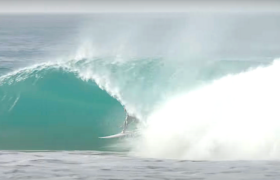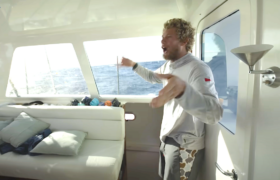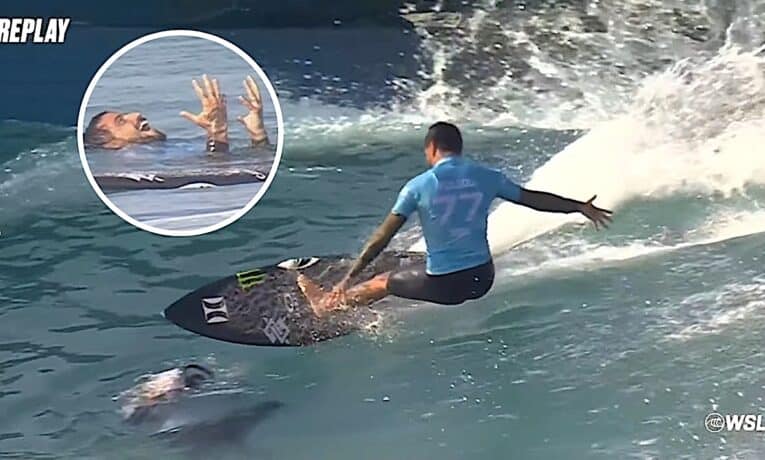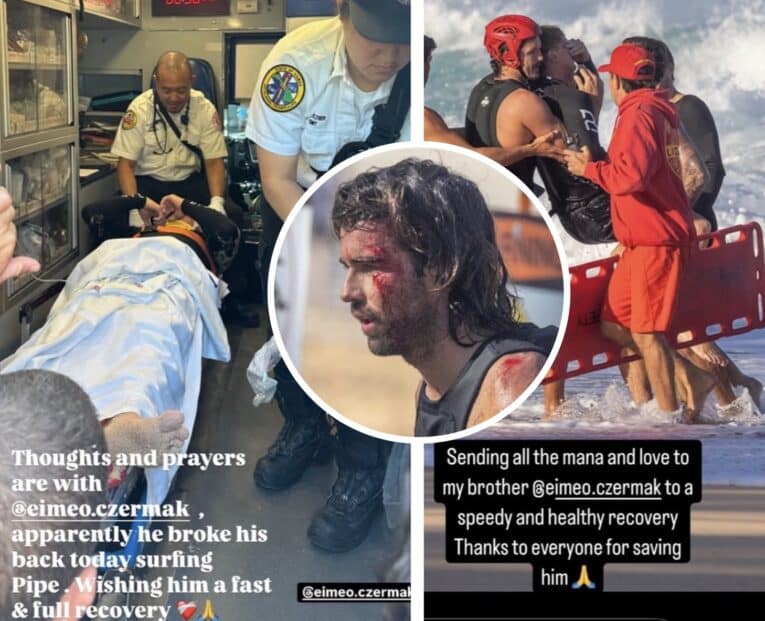Toledo now faces the unthinkable, requiring good results in real ocean waves that may be large.
“Look at this incredible facility,” chirruped Joe Turpel. “Look how far we’ve come.”
A drone hummed through the Arabian sky. It conveyed a streak of gleaming blue and astroturf green smeared amidst flat, arid sandscape.
On the horizon, buildings with indeterminable purpose gleamed like sentries.
Minitrue. Miniluv. Minipax. Miniplenty.
It was a phallic skyline. One building is an inexplicable red in the low desert sun. Sex toys for androids.
There is no undulation in this landscape. No geological processes to shape and carve. There is only the hubristically straight lines and fantasies of man and machine.
Look how far we’ve gone, Joe, I muttered quietly to myself.
Look how far we’ve gone.
“Bringing this really cool rush of surfing to another part of the world,” Joe returned.
“It’s always pumping, always perfect,” he continued in wilful blindness.
But it wasn’t. It was onshore. Man had harnessed waves but been smote by wind.
Regardless of how you feel about wavepools on a moral or aesthetic level, you can’t deny a rubbernecking curiosity at the absurdity of it all.
For all the WSL’s kelp farming, virtue-signaling, mother naturefelching, sustainable wokeness, here they are, in the Middle East, eons away from everything that is real, from all that surfing has been and done.
And everyone capitulates. There are no Tom Carrolls in 2025.
But it would take some thick moral fibres for surfers to stand against perfect waves. Regardless of your bent for social justice or anything else, in the face of perfect waves (offered freely by your employer, with a side serving of six star hospitality) your sense of morality would fold like the Burj Khalifa made of cards.
For the surf fan, there is multi-layered interest in this competition. Alongside morbid curiosity in the inevitable downfall of man, one might find interest in how surfers respond to scrutiny.
In the pool, technical skill and composure is laid bare. There is nowhere to hide.
What we find, somewhat predictably, is that the field of watchable competitors is scythed down. Look no further than the perennial contenders, all victorious in their opening round heats: Jack Robinson, Ethan Ewing, Filipe Toledo, Yago Dora, Griffin Colapinto, Italo Ferreira, Jordy Smith.
Really, these contests are a gambler’s dream. (Though not this one, owing to exclusion from bookmaker of choice.)
But what the competition has lacked so far, aside from the promised perfect waves, is any discernible tension.
Crowds are non-existent, despite the quite reasonable fees on Ticketmaster of twenty-five to forty of your Aussie dollars.
Heats took far too long to complete. Many were over with several waves left to surf, the winner already established.
One left and one right each should be sufficient for a wavepool competition. Cut the time. Crank the pressure.
Additionally, and somewhat bizarrely, there was no scoreboard on screen, and therefore no way of knowing what a competitor had already scored or what he might need unless the pundits told us.
Judges’ scores appeared from the digital ether fully formed. There was no waiting for one or two scores to drop. And there was even less sense than usual that human beings presided over the process.
It had all the tension of a dressage event. Watery prancings were punctuated by the occasional misstep, to muted disappointment.
Despite this, the contrast in approaches of some surfers was notable.
Italo Ferreira, the would-be world wavepool champ, a man whose game was built for this, was typically jangling. “I would love to have a close out on the end,” he chittered in his post-heat interview. “So I can go a little higher.”
Filipe Toledo, quite understandably, was similarly overjoyed to be back in his happy place. A safe haven of four-foot mechanical waves. He was noticeably quicker and more precise than anyone else. Up, down, up, down. Metronomic. He anatomises waves in pools with the assuredness of a kestrel dissecting a vole.
By contrast, Jack Robinson approaches the pool with the languid boredom of man for whom the predictability of waves presents little challenge. He was like a stud in the Red Light District, perusing easy game disinterestedly, before capitulating to his primal instincts and getting stuck in nonetheless.
Some surfers attempted a different visual approach with board colours, which I thought a savvy move to create separation in the sameness. Barron Mamiya opted for lurid orange, but this did little other than clashing with his yellow jersey. Yago Dora chose a flat blue deck with lime green rails, and had greater success.
In terms of visual appeal, I’d been expecting a little more than Lemoore, but it was much the same. The night surfing was a cool gimmick. But it didn’t last long. Eventually I zoned out and went full meta, thinking about thinking about surfing.
Until I was accosted by Miggy Pupo ripping the bag out of his lefthander under the lights. Worth watching for his Marzo-esque nosepick.
Really, the whole thing is about optics. And it’s hard to see ourselves as others see us.
Banality was momentarily broken, along with Toledo’s fins, in his round of 16 heat with Kanoa Igarashi. This marquee match up between two of the most likeable men on Tour had been dominated by Igarashi from the off, spurred on by the straight-talk of coach Jake Paterson.
Back against the wall, Toledo narrowed his beady eyes and attacked the right hander. But something was off. Mistiming his first couple of turns, he straightened his back and cruised through the middle section of the wave, before regaining consciousness and launching a huge alley-oop. But god had not forgiven him for the lapse. In his next cutback, he ran over a water photographer, breaking two fins. Whilst the poor lensman tried to crawl through the wire fence and commit hari kari in front of the wavetrain, Filipe slapped his board, threw a rash vest and used big sweary words. Lots of gesturing from hangers on indicated a desire for Pip to go again, but Renato Hickel deemed the scoring potential at that stage to have been insufficient. No more gravy for Pip.
Toledo now faces the unthinkable, requiring good results in real ocean waves that may be large.
My eight year old, completely apathetic to surfing, was transfixed by the pool.
“Come and see the cool surfing stunts!” he called excitedly through to his younger brother. He was a slave to the end section. The predictability of it all captivated him.
“Oh no, not the sea!” he exclaimed in the breaks between heats as we were shown drone shots of Bells and Peniche.
Oh no. Not the sea.
Look how far we’ve come.







